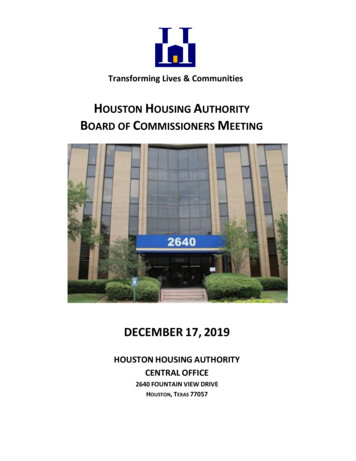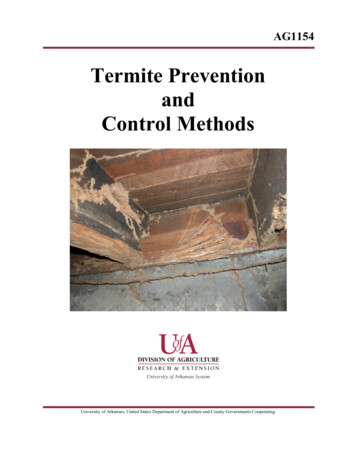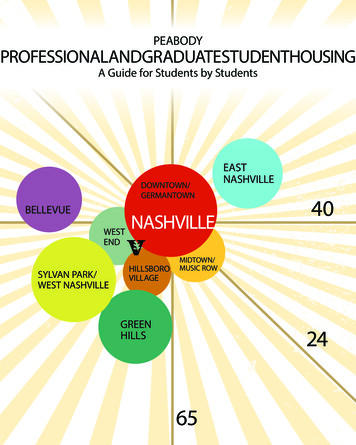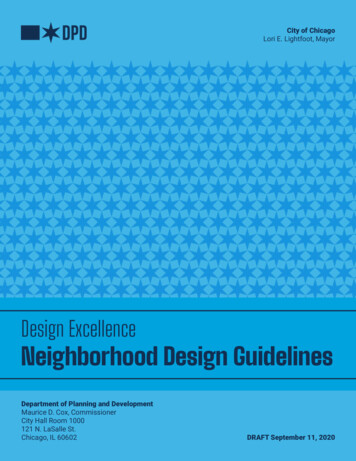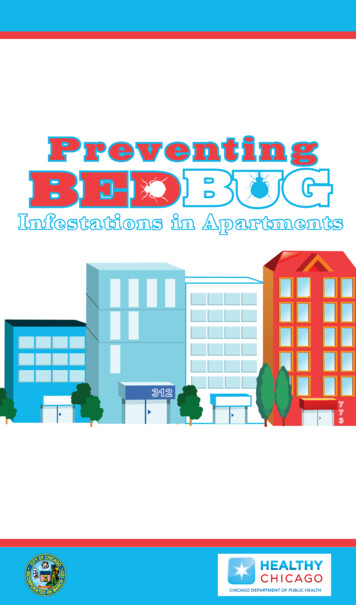
Transcription
Prevent in gInfestations in A partmentsCHICAGO DEPARTMENT OF PUBLIC HEALTH
Bed bugs can be found in homes, apartments, hotels, schools,dormitories, shelters, offices and other places. This brochure provides information on bed bugs and what you should do if you haveor suspect you have a bed bug infestation in your apartment. It alsodescribes your rights and responsibilities as a tenant.Why is this brochure being provided to me?In 2013, the City of Chicago passed an ordinance to help addressthe growing problem of bed bugs. This ordinance provides thatlandlords and tenants share the responsibility in preventing andcontrolling bed bug infestations. Further, the ordinance requiresthat landlords provide an informational brochure on bed bugs totenants. This informational brochure, developed by the ChicagoDepartment of Public Health, is intended to meet this requirement.What are bed bugs?Bed bugs are small, flat, wingless insects. They feed on blood and can bea nuisance for individuals. They arenamed for their tendency to live onmattresses or other parts of a bed.*Adult bed bug-actual size.What do bed bugs look like?Adult bed bugs are roughly the size,shape and color of an apple seed: 1/4 of an inch in length and lightor reddish-brown in color. Immature forms of bed bugs are smallerand lighter in color. Eggs are tiny and white. You should be able tosee the adult form with your naked eye, but may need a magnifying glass to see the immature forms or eggs. Please refer to thewebsite listed at the end of this brochure for pictures of bed bugs.Where do bed bugs live?Bed bugs can be found anywhere people sleep, sit or lay down.They can be found on mattresses and box springs, especially nearthe piping, seams and tags, and in cracks and crevices of headboards and bed frames. They can also be found in other furniture,especially in the seams and zippers of chairs and couches, in thefolds of curtains, in drawer joints, in electrical outlets, behind picture frames and in other tight spaces.1
How can bed bugs get into an apartment?Bed bugs can get into an apartment by hitching a ride on mattresses or other bedding, furniture, clothing and baggage. Oncein an apartment, they can crawl from one room to another, or getinto an adjacent apartment by crawling through small cracks orholes in walls or ceilings or under doors. Because bed bugs donot have wings, they cannot fly into or around your apartment.What can I do to prevent bed bugsfrom getting into my apartment?Bed bugs can be found most anywhere, so ALWAYS be aware of yoursurroundings. Always check furnitureand bedding, especially those boughtsecondhand, for signs of bed bugs before you buy them. NEVER bring items that someone else hasdisposed of into your apartment, as these items may be infestedwith bed bugs. When returning home from travel within or fromoutside the U.S., ALWAYS inspect your luggage carefully for signsof bed bugs before you bring the luggage into your apartment.What else can I do to prevent a bed bug infestation?Reduce clutter, especially in bedrooms. Store unused items insealed containers or plastic bags. Wash and dry bedding often.Check beds and furniture for signs of bed bugs. Purchase mattress and box spring covers.Do bed bugs transmit disease?No, bed bugs are not known to transmit disease.Are there other health concerns related to bed bugs?Yes. Their bites, like those of other insects, may cause an allergicreaction with swelling, redness and itching. Their presence maycause people to be anxious and lose sleep.How do I know if I have a bed bug infestation in my apartment?Though bites may be an indicator of a bed bug infestation, theyare generally a poor one as not all people will react to bed bugbites or the bites may be due to other reasons. The best indication of an infestation is to look for physical signs of bed bugs suchas live or dead bed bugs, eggs or eggshells or tiny dark spots orreddish stains on mattresses or other places where bed bugs live.2
What should I do if I suspect there are bed bugs in my apartment?Under this ordinance, tenants MUST call their landlord immediately then follow-up in writing. Tenants SHOULD NOT try to getrid of the bed bugs by applying chemicals, “bug bombs” or pesticides as these do not work and could make you, your family orneighbors sick. Once a tenant has notified the landlord, wait foradditional instructions from the landlord and pest managementprofessional. Prompt notification and treatment will help preventthe further spread of bed bugs.Should I dispose of bedding, clothing or other materialsthat may be infested?Disposing of these items is probably not necessary unless directed by a pest management professional. If there are items thatdo need to be disposed of, do so carefully by sealing them inplastic bags so as to not spread bed bugs further. The ordinanceprohibits the recycling of any bed bug infested materials and requires that any bed bug infested materials be totally enclosed ina plastic bag and labeled as being infested with bed bugs whendisposed.What should I do with any linens or clothes that may beinfested? Wash all linen and other infested materials (including clothing)in hot water, then after drying the clothes, keep them in thedryer and dry for an additional 20 minutes on the highest setting. Put un-washable or “dry clean only” materials in the dryeron the highest setting for at least 20 minutes. If you have to launder in a common area of the building or ata laundromat, make sure all items are enclosed in a bag beforeleaving your apartment to prevent the further spread of bed bugs. Once all these materials are laundered and dried, seal themin clean bags so bed bugs can’t re-infest them.What are my responsibilities as a tenant under thisordinance?Tenants have two main responsibilities under this ordinance:1) Notify your landlord within 5 days of suspecting a bed bug infestation;2) Cooperate with the landlord by adhering to the following:3
Don’t interfere with an inspection or with a treatment. Grant access to your apartment for an inspection or a treatment. Make the necessary preparations, as instructed by your landlord or a pest management professional, prior to an inspection or a treatment. Dispose of any items that a pest management professionalhas determined can not be treated or cleaned. Enclose in a plastic bag any personal property that will bemoved through any common area of the building, or storedin any other location.Are there any exemptions to these tenant responsibilities?Yes. The ordinance exempts tenants who live in an assisted livingor shared housing establishment, or similar living arrangement,where the establishment is required to provide the tenant assistance with activities of daily living or mandatory services. In suchcases, the landlord is responsible for making the necessary preparations and removing or disposing of any personal property.What penalties can a tenant face for not complying withthese requirements?The ordinance allows the city to issue fines to tenants for notcomplying with these requirements. Fines can go as highas 2,000 for a third offense. Landlords can not fine tenants.What are my rights as a tenant under this ordinance?Landlords can’t retaliate against a tenant if the tenant: Complains of a bed bug infestation to a governmental agencyelected representative or public official charged with responsibility for enforcement of a building, housing, health or similar code. Complains of a bed bug infestation to a community organizationor to the news-media. Seeks the assistance of a community organization or thenews-media to remedy a bed bug infestation. Asks the landlord to provide pest control measures. Testifies in court concerning any bed bug infestation.4
What are my landlord’s responsibilities under thisordinance?Landlords have three main responsibilities under this ordinance:1) Educate tenants about bed bugs by providing this brochurewhen tenants sign a new or renew an existing lease or otherrental agreement;2) Notify tenants prior to any inspection or treatment of theirapartment for bed bugs and provide instructions for preparing the apartment.3) Get rid of the beg bug infestation by providing pest controlservices by a pest management professional and paying forthis service.How much time does a landlord have to provide a pestmanagement professional?The ordinance allows landlords up to 10 days to have a pestmanagement professional come to inspect your apartment.Does the ordinance require any specific type of inspection ortreatment?If bed bugs are in an apartment, there is a chance they may befound in additional apartments in that same building, especiallythose closest to the apartment with the bed bugs. As a result,the apartments on either side and directly above and below theapartment with the bed bugs need to be inspected and if necessary, treated. Treatment will only occur if bed bugs are found.Do these requirements apply to condominiums orcooperative building:Yes, but only to units that are being rented.What penalties can a landlord face for not complyingwith these requirements?The ordinance allows the city to issue fines to landlords for notcomplying with these requirements. Fines can go as high as 2,000 for a third offense.5
What should I do if my landlord is not responsive?If you suspect there are bed bugs in your apartment, call yourlandlord immediately and follow-up in writing. Give your landlordup to 10 days to have a pest management professional come toinspect your apartment. If your landlord is not responsive, call311 and file a complaint.Additional information, including a copy of the ordinance, can befound at:www.cityofchicago.org/healthFollow us on Twitter & O DEPARTMENT OF PUBLIC HEALTH6
as live or dead bed bugs, eggs or eggshells or tiny dark spots or . tance with activities of daily living or mandatory services. In such cases, the landlord is responsible for making the necessary prep-ara
